Unit8教学设计(1)
- 格式:doc
- 大小:77.00 KB
- 文档页数:12
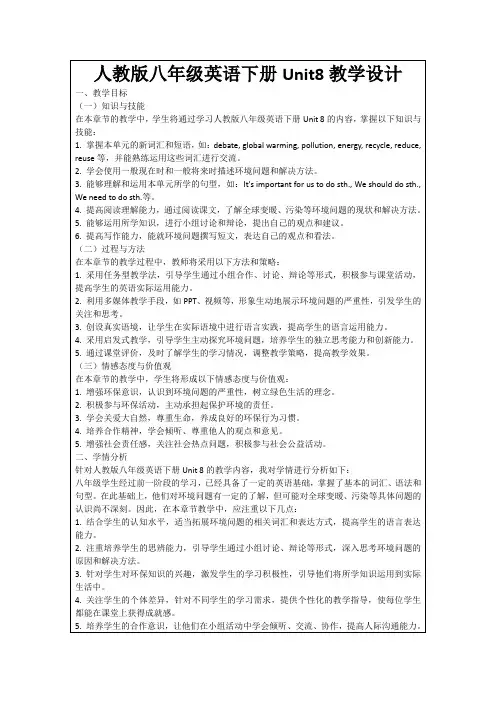
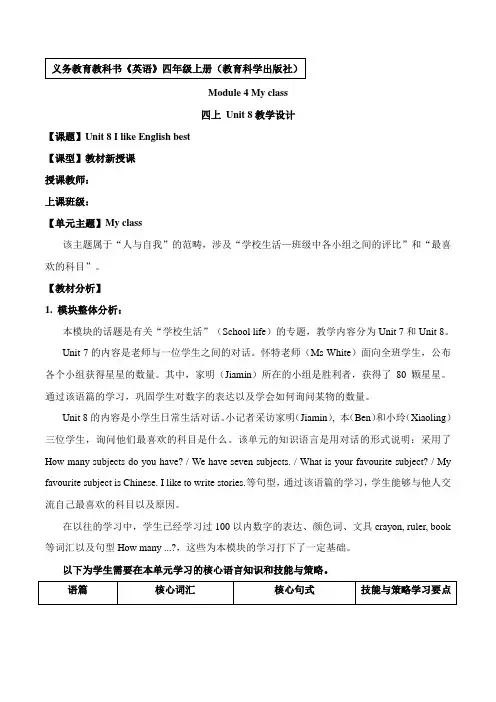
Module 4 My class四上Unit 8教学设计【课题】Unit 8 I like English best【课型】教材新授课授课教师:上课班级:【单元主题】My class该主题属于“人与自我”的范畴,涉及“学校生活—班级中各小组之间的评比”和“最喜欢的科目”。
【教材分析】1. 模块整体分析:本模块的话题是有关“学校生活”(School life)的专题,教学内容分为Unit 7和Unit 8。
Unit 7的内容是老师与一位学生之间的对话。
怀特老师(Ms White)面向全班学生,公布各个小组获得星星的数量。
其中,家明(Jiamin)所在的小组是胜利者,获得了80颗星星。
通过该语篇的学习,巩固学生对数字的表达以及学会如何询问某物的数量。
Unit 8的内容是小学生日常生活对话。
小记者采访家明(Jiamin), 本(Ben)和小玲(Xiaoling)三位学生,询问他们最喜欢的科目是什么。
该单元的知识语言是用对话的形式说明:采用了How many subjects do you have? / We have seven subjects. / What is your favourite subject? / My favourite subject is Chinese. I like to write stories.等句型,通过该语篇的学习,学生能够与他人交流自己最喜欢的科目以及原因。
在以往的学习中,学生已经学习过100以内数字的表达、颜色词、文具crayon, ruler, book 等词汇以及句型How many ...?,这些为本模块的学习打下了一定基础。
以下为学生需要在本单元学习的核心语言知识和技能与策略。
本节课Unit 8以对话展开,文章没有长难句,但学生要流利地朗读全文,并准确地运用词汇、短语和句型进行问答,有一定难度。
文章内容比较贴近学生的生活,学完本课,学生除了掌握单词、短语,也要能理解课文并尝试用所学句型,围绕主题“最喜欢的科目”进行问答。

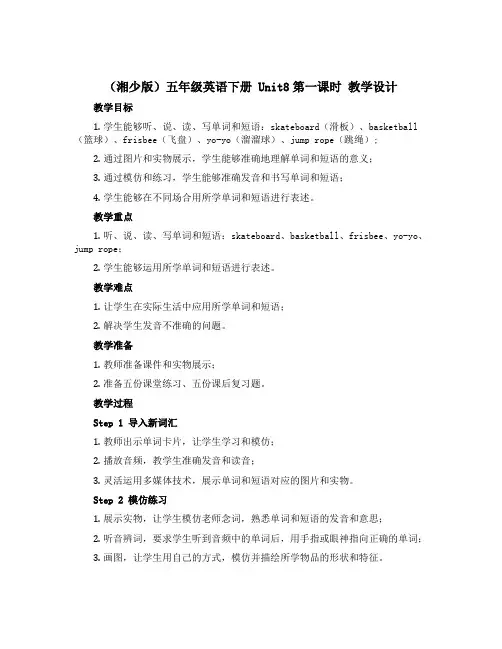
(湘少版)五年级英语下册 Unit8第一课时教学设计教学目标1.学生能够听、说、读、写单词和短语:skateboard(滑板)、basketball (篮球)、frisbee(飞盘)、yo-yo(溜溜球)、jump rope(跳绳);2.通过图片和实物展示,学生能够准确地理解单词和短语的意义;3.通过模仿和练习,学生能够准确发音和书写单词和短语;4.学生能够在不同场合用所学单词和短语进行表述。
教学重点1.听、说、读、写单词和短语:skateboard、basketball、frisbee、yo-yo、jump rope;2.学生能够运用所学单词和短语进行表述。
教学难点1.让学生在实际生活中应用所学单词和短语;2.解决学生发音不准确的问题。
教学准备1.教师准备课件和实物展示;2.准备五份课堂练习、五份课后复习题。
教学过程Step 1 导入新词汇1.教师出示单词卡片,让学生学习和模仿;2.播放音频,教学生准确发音和读音;3.灵活运用多媒体技术,展示单词和短语对应的图片和实物。
Step 2 模仿练习1.展示实物,让学生模仿老师念词,熟悉单词和短语的发音和意思;2.听音辨词,要求学生听到音频中的单词后,用手指或眼神指向正确的单词;3.画图,让学生用自己的方式,模仿并描绘所学物品的形状和特征。
Step 3 技能练习1.单词拼写,教师对所学单词和短语发音,学生写出相应的英文字母;2.短语分类,将学生批量写出所学的五个短语,分类成运动器材类和娱乐项类;3.句子造型,让学生用所学单词和短语造几个简单的短句。
Step 4 课堂小测验1.随堂考核学生对所学内容的认识和掌握程度;2.考核形式:选择题、填空题和配对练习。
Step 5 课后作业1.学生回家复习;2.教师发给学生5份课后习题,变式选择题,选做题型;3.课后复习题以所学内容为基础,可适当拓展和扩展。
教学评价1.结合平时表现、课堂发言和测试情况等多方面考评学生;2.经常及时给学生反馈,帮助学生提升学习成效。
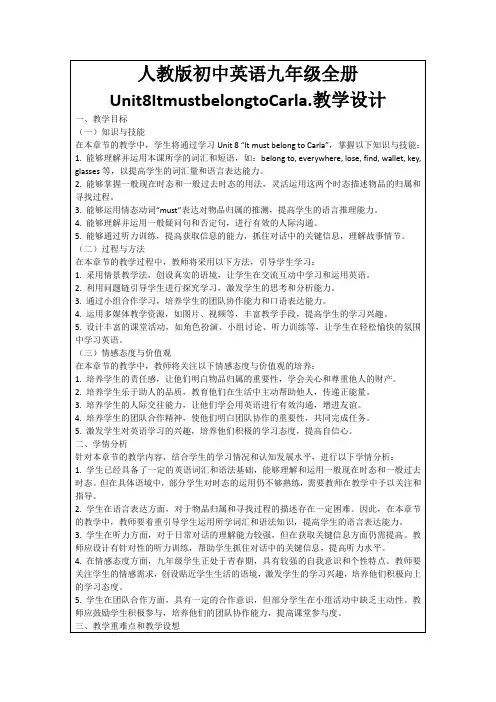
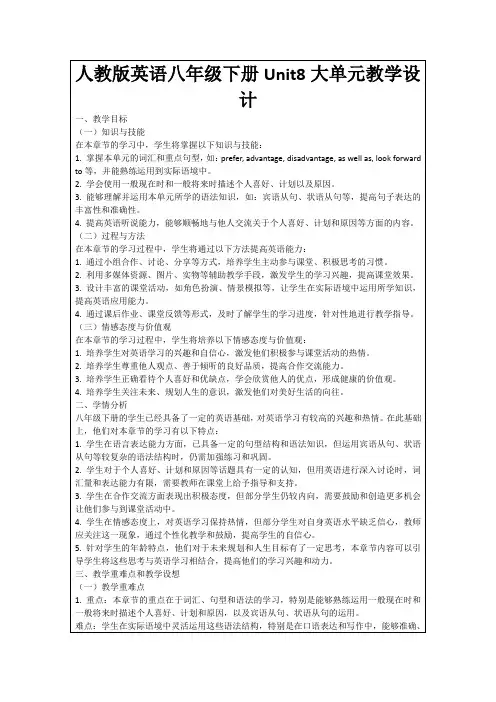
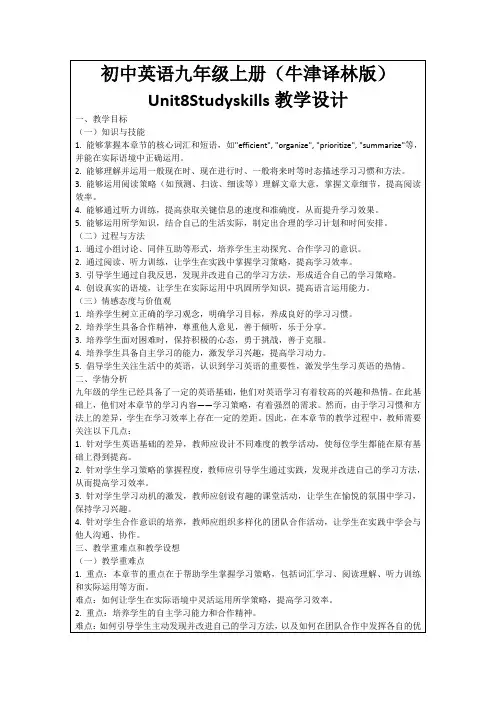
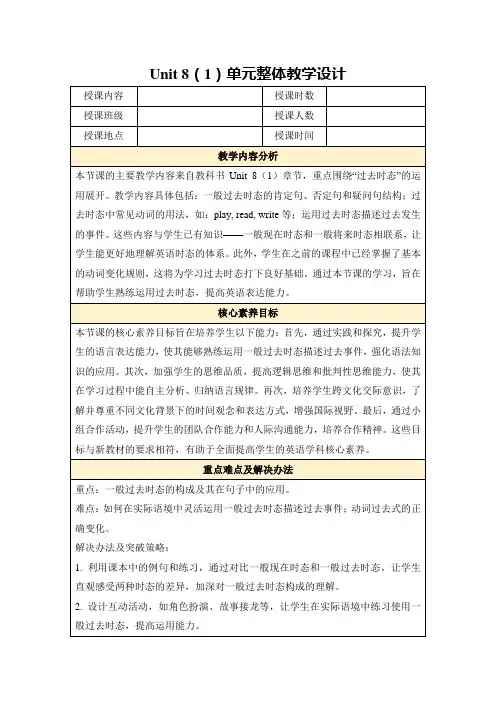
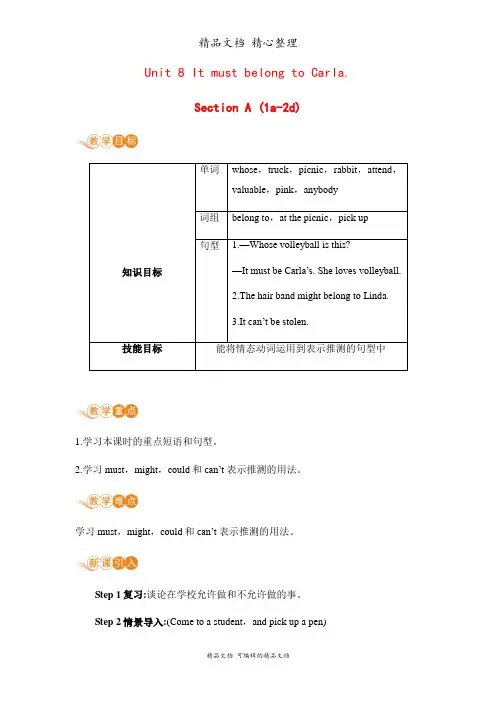
Unit 8 It must belong to Carla.Section A (1a-2d)单词whose,truck,picnic,rabbit,attend,1.学习本课时的重点短语和句型。
2.学习must,might,could和can’t 表示推测的用法。
学习must,might,could和can’t 表示推测的用法。
Step 1复习:谈论在学校允许做和不允许做的事。
Step 2情景导入:(Come to a student,and pick up a pen)T:The pen is Huang Ming’s. We can also say,“The pen belongs to Huang Ming.”Now please make sentences with your school things like this.环节说明:该环节过渡自然,介绍词组belong to的用法。
Step 3完成教材1a-1c中的任务:1.在1a表格中相应的栏目下补充更多你看到的物品。
2.听录音,根据对话内容,将1b表格中的人物、物品和原因相匹配。
3.再听一遍录音,并跟读对话。
4.两人一组练习1c中的对话,然后根据1b中的信息仿照1c的形式编新的对话。
5.小结训练根据汉语意思完成句子(1)走了这么远的路,你一定饿了。
You hungry after all that walking.(2)这个卡车玩具属于鲍勃。
The toy Bob.(3)这是谁的自行车?is this?答案:(1)must be(2)truck belongs to (3)Whose bike1.— model plane is this?—I think it’s Jim’s. Look, his name is on it.A.WhoB.WhatC.WhoseD.Where答案:C who意为“谁”;what意为“什么”;whose意为“谁的”;where意为“哪里”。

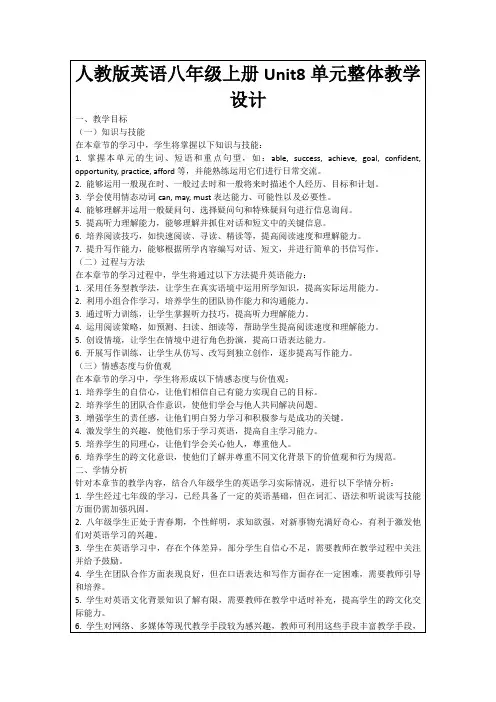
Unit 8 How do you make a banana milk shake?Section A 1 (1a-2d)一、教学目标:1. 语言知识目标:1) 能掌握以下单词: shake, milk shake, blender, turn on, peel, pour, yogurt, honey, watermelon, spoon, pot, add, finally, salt能掌握以下句型:①─How do you make a banana milk shake?─First, peel the bananas…②─How many bananas do we need?─We need three bananas.③─How much yogurt do we need?─We need one cup of yogurt.2) 能了解以下语法:掌握用how much 和how many对事物的数量提问。
3) 学会描述做一些常见食物的过程,并能正确地运用表示顺序的词汇。
2. 情感态度价值观目标:1. 通过制作食物的介绍, 培养学生的实际生活能力, 了解生活知识, 增长生活阅历, 培养实践操作能力和动手能力。
2. 通过食物制作过程的介绍, 让学生认识到劳动成果的来之不易, 使之懂得不能浪费食物, 珍惜他人的劳动成果。
二、教学重难点1. 教学重点:1) 用how much与how many来对数量提问。
2) 动词词组;描述过程的顺序词。
2. 教学难点:能恰当地使用祈使句表达食物的制作过程。
三、学法指导1.学习方法的指导培养学生观察力,记忆力,想象力以及创造能力。
用生动的课件进行听、说、读、写的训练。
2.学习能力的培养通过连贯的听、说、读、写、表演等技能,培养学生的交际能力,发展他们的思维能力。
3.学习策略的指导在课堂教学中把学生分成两人或四人小组的学习小组,让他们围绕着课堂任务相互交流、相互合作,从而获得知识、技能和情感体验,发展学生的自主学习能力。
英语八年级上Unit8第一课时教学设计1教学目标:一、知识与能力:1.语言知识目标:通过学习使学生掌握并能熟练运用四会三会词语和句型。
Words: milk, shake, ingredient ,blender ,teaspoon, peel, cut up, pour .... into .... , turn on ,turn off,first ,next then, finally.Sentences: Peel three bananas等祈使句2.语言技能目标:能运用所学词汇句型描述奶昔制作过程,能在真实情景中熟练运用。
二、.过程与方法:通过听说读写等任务型活动,熟练应用所学单词和动词词组,能听从奶昔制作指令,并且掌握奶昔制作全过程。
三、情感态度与价值观:通过创设人文情景,学生身临其境感受和体验,使语言学以致用,激发学生的学习积极性。
体会在活动中学习英语的乐,。
培养学生乐于与他人合作的精神及爱生活,孝敬父母和爱做家务的好习惯。
四、文化意识目标:了解西方人的饮食文化。
2学情分析:本课教学对象为八年级的学生。
这一阶段的学生思维能力发展较快,自我意识增强,在情感方面能进行自我教育,好奇心强,喜欢探索新鲜的事物,喜欢动手参与,也喜欢竞赛。
经过一年的新课程理念的熏陶及实践,有了初步的自主、合作、探究、实践的能力。
因此我将此课设计为活动课,并引入竞争机制,满足学生学习需要。
3教学重点重点:学习制作奶昔所需的相关词汇和句型。
难点:学会制作奶昔、沙拉并描述其过程。
4.教学程序:Step 1 Warm up and lead in.1.Get the students to enjoy a piece of flash show. Greedymonkey .2.Then ask students what kind of fruit they see?Students say the names of the fruit one by one.T: Why do you like fruit ?S1: Beacause it is healthy.S2: Beacause it is delicious. Today we are going to learn how to make a banana milk shake . Do you want to know how to make it?设计意图:采用兴趣型教学策略,多媒体呈现水果激发学生探索的动机和愿望。
Unit 8 Green Living Roots and shoots 教学设计Roots and Shoots课标分析本文是北师大版高中英语必修三Unit 8中的一篇文章,本节课是这个单元的第一个课时,主要介绍了环境保护组织“Roots and Shoots”,本课是北师大版第八单元的第一个课时,这一单元的主要话题是green living,主要介绍了环境保护组织"Roots and Shoots”,文章展开了一个话题,那就是节约能源,人和动物、植物的和谐,这篇文章属于人和社会这个主题,介绍了一些能源浪费的现象和"Roots and Shoots”的发展。
这篇文章暗示了人类、社会和自然的多重信息,还有作者的思考和感受,使学生在阅读的过程中明白勿以善小而不为,勿以恶小而为之,保护环境需要每个人的努力。
文中生词量不大,文章结构比较简单;阅读难度不大,但是如何引导学生归纳总结给教学设计带来了极大的困难。
《普通高中英语课程标准》要求教师侧重于培养学生的阅读策略;培养语感;特别强培养学生在阅读过程中获取和处理信息的能力。
由于我所教班级的学生英语水平一般,因此,我将本课的教学目标设定为:1.语言技能目标:(1)能够用所学单词,句子介绍Roots and Shoots。
(2)能够运用所学知识说服他人加入到保护环境中来。
(3)能够完成课堂所给任务。
2.语言知识目标:能够正确运用以下单词:bother ;not be bothered to do;take action;firm foundation;brick;all around the world 等3.文化意识目标:能够明白保护环境人人有责4.情感态度目标:(1)意识到环境保护需要每个人的努力。
(2)积极从自身做起,保护环境。
(3)明白勿以善小而不为,勿以恶小而为之。
根据既定教学目标,我设计了以下的教学模式:课前:1. 认知本模块生词(非7、8级词汇不要求拼写)2. 通过互联网查找了解roots and shoots,并要求课前能够简要表述其特色。
Unit8 What’s Your Dream第1课时教学设计【内容来源】陕旅教育出版社六年级下册Unit8【主题】Warming-up: Ask and answer, Let’s lea rn, Let’s chant【课时】第1课时一、教学目标1. 能听、说、读、写词汇:become a tour guide, travel around the world, land on the moon, go to college Join the National Team, study the stars。
2. 能用I want to ...初步表述自己的梦想3. 能积极与他人合作,共同完成学习任务。
二、教学准备1. 教师准备Let’s learn部分的词汇教学卡片。
2. 教师准备本课时的PPT教学课件。
3 教师准备Let’s learn和Let’s chant部分的教学音频。
4. 教师准备一个沙包。
三、教学方法建议课程导入(Leading In)(1)课前问答Part A Warming-up: Ask and answer1. 教师借助本部分的对话示范,挑选三四个学生进行问答,复习已学过的职业词汇:T: What is your father?S1: He is a driver / police officer /...T: What does your mother do?S1: She is a teacher / nurse / reporter / ...2. 请学生结合实际情况就彼此家人的工作自由会话。
(2)新课导入教师检查学生的会话情况,并继续话题,逐步引人新课。
S1: What’s your father?S2: He is a doctor.T: Your father is a doctor, so do you want to be a doctor?S2: No.(根据学生的回答教师随机发问。
Unit 8 Is there a post office near here? 教学设计Language goalThis unit students leam to ask for and give directions(方向) on the street.New languageIs there a bank near here? Yes, there's a bank on Center Street, Where's the supermarket? It's next to the library.Is there a pay phone in the neighbhood?Yes, it's on Bridge Street on the right. locations in the neighborhood such as post office, hotel,video arcade.Descriptive words such as new, old, dirty, clean.Descriptions of location such as across from, next to,BetweenRecycled languageWhat are you doing?Do you want to ...?Section AAsk two rows of three students each to stand facing each other in the front of the classroom. Point to students standing in front and ask the class to repeat the questions and answers.Example 1Teacher: Where'sYang Li? (Point to two students standing beside each other.) Yang Li is next to Li Peng.Example 2Teacher: Where's Zheng Wen? (Point to two students in different lines facing each other.)Zheng Wen is across from Sheng Lin. Example 3Teacher: Where's Lin Jiahui? (Point to one student standing between two other students.) Lin Jiahui is between Sheng Lin and Li Dai.la This activity introduces the key vocabulary.Focus attention on the picture. Ask students to name as many of the places they see in the picture as they can.Then name all the places and ask students to repeat.Point out the numbered list of words. Say each one and ask students to repeat.Then ask students to match each word or phrase on the list with one of the pictures. Say, Write the letter of each place in the picture next to the correct word or words on the list. Point out the sample answer f.Check the answers.1b This activity gives students practice listening to and understanding the target language.Point out the buildings and other locations in the picture. Say the name of each one to the class.Say, Now I will play recordings of three conversations. Listen carefully and circle the picture of each place you hear on the tape..Play the recording the first time. Students only listen.Play the recording a second time. This tine ask students to listen and circle the items they hear on the picture.Correct the answers.These items should be circle:video arcade, post office, supermarket.Tapescript(录音稿)Convernation 1A: Is there a video arcade on Fifth Avenue?B: Yes, there is.Conversation 2A: Is there a post office near here?B: Yes, there is. There's one on Bridge Street.Conversation 3A: Is there a supermarket on Center Street?B: No, there isn't.1C This activity provides guided oral practice using the target language.Point to the different locations shown in the picture.Ask different students to name each one. If necessary,say the name and ask the student to repeat.Point to the question and answer In the example conversation and ask a pair of students to read the conversation to the class.Ask other pairs of students to repeat the activity if you wish.Ask students to work in pairs. Say, First one person asks a question and then the other person takes a turn.Demonstrate(示范)the activity. Point to the picture and ask. Is there a post office near here? Then choose a student to answer.Guide the student to say, Yes,there's a post office on Bridge Street.As students work, move around the room and check progress(进展情况).Help students understand how to locate things on the map, if necessary.Ask several students to say some of their questions and answers for the class.教学后记:教学方法有问题?教了这么多年的英语,总幻想有一种方法,能让学生轻轻松松把英语学好。
哪怕自己多浪费点时间。
有时想来,自己的教学效率实在是太低了,每天不分上课上自习,都是一个样。
也就是说在不误课的情况下,我的教学时间应该是学校规定时间的两倍,然而教学的效果却很不理想。
每天看着自己的队伍步履蹒跚的前行,自己不由的怀疑自己的教学方法。
与此同时,这段时间由于我在学生每天记十个词前,先领读他们一遍,再分开音节,讲一讲英语的拼读规则,发现学生的记忆效率大大的提高,这更让我有理由怀疑自己的教学方法是不是不适合学生的实际?吃早饭时突发“奇想”,是不是给学生一点时间,让他们把每单元几句重点句背下来更好呢?单词需要积累,这点勿容置疑。
对于我们的学生来说,典型句子同样需要积累。
句子背下来,在用的时候就可以举一反三,就像语文中背范文一样。
对于我们我们这些基础较差的学生来说,他们在交际时需要模仿,在他们的记忆库中贮存就是十必要的。
当然,如果学生能够在课堂上用英语去表达的话,说明这些典型的句子他们已经掌握。
但现实的情况是,这种方法更容易适用于尖子生,或者基础较好的学生,很多学生只是充当的观众。
让学生死记硬背是不对的,但不让学生背也是不对的。
2a This activity introduces the terms across from, next to, between, and on.Focus attention on the pictures. Ask students to talk about the pictures, naming as many places as they can.Then name all the places in the pictures and ask students to repeat.Point out the four sentences. Say each one and ask students to rcpeat.Then ask students to match each sentence with one of the pictures. Say, Eacb sentence talks about one of the pictures. Write the number of the sentence in the box on the picture that it is talking about. Point out the sample answer 1.Check ihc answers.2b This activity gives students practice listening to and understanding the target language.Point out the buildings and street names in la.Say each one and ask students to repeat.Call attention to the four sentences in 2b. Read them to the class saying blank each time you come to a blank line.Say. Now I will play recordings of three conversations. Listen carefully and write a word from the box on each blank line. Point out the sample answer.Play the recording the first time. Students only listen.Play the recording a second time. This time ask students to fill in the blanks by listening to the items on the tape.Correct the answers.Tapescript(录音稿)Conwaraation 1A: Excuse me. Is there a library around here?B: Yes. It's between the video arcade and the supermarket. Conversation 2A: Where's the park?B: The park? Oh, it's across from the bank.Conversation 3A: Excuse me. Is there a supermarket around here?B; Yes, it'son Fifth Avenue.Conversation 4A: Where's the pay phone?B: It's next to the post office.2c This activity provides guided oral practice using the target language.Point to the list of buildings in la. Ask a student to read the list aloud.Point to the question and answer in the speech bubbles( 泡沫) in 2c and ask a pair of students to read the conversation to the class. Ask other pairs of students to repeat the activity if you wish.Ask students to work in pairs. Say, First one person asks a question and then the other person takes a turn. Ask about the buildings in 1a.Demonstrate(示范)the activity. Point to the map and ask,Where's the park? Then choose a student to answer.Guide the student to say, It's across from the bank.As students work, move around the room and check progress.(进度)Ask several students to say some of their questions and answers for the class.Grammar focusReview the grammar box. Ask students to say the questions and answers.Ask students to circle these words in the grammar focus section of their books: on, across from, next to, and between. Ask, Which words talk about two different buildings? (across/row, next to, and between) Ask, Which one talks about one building all alone!' (on)Culture noteMany visitors to the United States believe that Americans don't like to answer questions or give directions(方向) to tourists(旅行者)and other visitors. This is not necessarily true. The pace of life is fast in the United States, especially(特别)in big cities. Most people walk quickly, talk quickly, and are in a hurry to get wherever they are going. Also, most Americans speak only one language and aren't used to talking with speakers of other languages. However, when a visitor asks a question,many people are pleased to be able to share their knowledge of their city or their neighborhood. A pleasant smile and a short, direct question will almost always get you the information you need.3a This activity provides target-oriented reading practice using the language items taught in this unit.Draw attention to the conversation in the box. Ask students to read it out loud.Ask a student to point out the place that Paul wants to get to.Guide the student to point to the book and say,Here's the hotel.Here's Bridge Street.Point to the two arrows.(箭头) Ask students to repeat left and right. Then ask them to hold up their left hands and then their right hands.Ask students to read the conversation again. Then ask them to find Paul and Nancy in the picture.AnswerPaul and Nancy are the two figures outside the entrance to the park.3b This activity provides guided writing practice using the target language.Call attention to the three pictures. Explain that the three pairs in these pictures correspond to three pairs in the large picture above. Ask students to find the pairs in the big picture.Point to the questions below each picture and ask a student to read them aloud.Point to the three write-on lines in the speech bubbles. Say, Write the answers to the questions here.Ask students to complete the writing individually.(个别的) Correct the answers.1. Yes, there is. Go straight down New Street and turn right. There's a pay phone on the right.2. Go straight down New Street and turn right. Turn left at Bridge Street. The bank is across the street.3. Yes, there is. Turn right, then go straight down Bridge Street. The post office is on the left. It's across from the video arcade, next to the super-market.4 This activity provides guided oral practice using the target language,Call attention to the picture in la. Ask students to name all the buildings in the picture.Point out the conversation In the picture in 4.Ask different students to read each line.Have the students work In groups.One person chooses a building in the la picture but doesn't tell anyone which building it is. The others ask questions like those in the activity 4 picture until they guess which building it is.Several students can take turns choosing the building for the others to guess.Section Bla This activity introduces the key vocabulary.Focus attention on the pictures. Ask different students to name the places shown in the pictures. They will probably not include words such as old, new, busy, quiet, big, small, dirty, and clean in their statements.Point to and name all the places in the pictures again without the describing words and have students repeat.Now point to each half of each picture and ask about the difference between the halves. For example, you might say;This is a park. Is it a clean park or a dirty park? Clarify(澄清) the meaning of the words clean and dirty by pointing out details in the pictures.Point out the pairs of words or phrases. Say each one and ask students to repeat,Then ask students to match each word or phrase on the list with one of the pictures. Point out the sampl answer.Check the answers.1 b This activity provides guided oral practice using the target language.Call attention to the conversation in the picture.Ask a pair of students to read it aloud. Then ask several different students the same question. Ask them to tell the truth.Point out the list of phrases in 1a. Ask students to work in pairs They take turns asking each other questions about the things on this list. Ask them to tell each other the truth.As students work together, move around the room checking on their progress.Ask several students to present some questions and answers to the class.2a This activity gives students practice listening to and understanding the target language.Point out the list of places in la. Say die name of each one to the class.Say, Now I will play a recording of a conversation.Listen carefully and circle the words in 1a that tell about Michael's street.Play the recording the first time. Students only listen.Play the recording a second time. This time ask students to listen and circle the places they hear.Correct the answers.2b This activity gives students practice listening to and understanding the target language.Call attention to the street map in the box.Say, Now I will play the conversation again. Listen to if and draw the places in Michael's neighborhood on the street map. Play the recording. Students only listen.Demonstrate the activity by saying. What are the three places on the tape? (a hotel, a supermarket, Michael's house). Answer any questions students may have.Play the recording again.Students draw maps of Michael's neighborhood.Move around the room, offering assistance(提供协助) if needed. Have some students show their completed drawings to the class.2c This activity provides guided oral practice using the target language.Say, Now let's work in pairs. The first person makes some statements about the picture in 2b. The seconds person says "true" if the statement is true and "false if the statement is false.The second person also changes each false statement into a true one.Call attention to the conversation in the picture in 2c. Ask a pair of students to read it aloud.Demonstrate(示范) the activity with a student. Have the student close the book. Then say one true thing and one false thing about the picture. Guide the student to answer "true" for the true statement and to say "false" for the false statement and change it into a true one.Ask students to practice in pairs and to take both roles. Move around the room helping students get started| and answering any questions they may havc.Ask several pairs of students to present some statements and responses(回答) to the class.Ask students to correct any mistakes they hear.3a This activity provides reading practice using the target language.Ask a student to read the paragraph to the class or read it yourself.Answer any questions students may have.Read the Instructions(指示)aloud. Point out the sample of the circled description word (busy), and make sure students understand what they have to do.Correct the answers.3b This activity provides guided reading and writing practice using the target language.Point out the guide and the blank spaces in it.Read it aloud saying blank each time you come to a blank line.Say, Now please write one word in each blank space in the guide. Look at the picture/or the answers.Point out the sample answer in the blank.Correct the answers.3c This activity provides guided writing practice using the targetlanguage.Ask students to work on their own. Point out the description in 3b and say. Now write about your own neighborhood. Use sentences like these.4This activity provides open-ended oral practice using the target language.Call attention to what the person In the picture is saying. Ask a student to read the statement to the class.Say,Now you can talk with your partner about your own neighborhood. Tell about the streets and buildings. Your partner will draw a picture of the neighborhoodDemonstrate the activity with a student. Have him or her make some statements and draw on the board what you hear.For example, you might draw a small supermarket across from a post office.As students work, move around the room offering assistance and answering questions.Ask some students to share(参与) the completed drawings and to make some statements to accompany(陪伴) them.Self check1 This activity provides a comprehensive review of all key vocabulary presented in this unit.Ask students to check all the words they know. You may wish to have them circle any words that they don't know.Ask students to find out the meanings of any words they don't know. They can do this by reviewing the unit.asking you, asking their classmates or using a learner's dictionary or bilingual dictionary.2 This activity helps build vocabulary by providing a specific time and place for students to record new words.Ask students to enter five new words in their Vocab-builder on page 108.After students have recorded their new words, ask them to share their lists with other students. This can be done with the whole class or informally, in pairs or small groups.3 This activity provides reading practice focusing on the gmmmatical structures used to ask and say where things are.Ask students to read the letter and draw the route on the map.Answer any questions students may have.Check the answers. (You may want to draw a simple copy of the map on the board, and then have one student come and draw the route on it.)教学后记:培养学生的自信心和兴趣是最重要的培养学生的自信心和兴趣是最重要的吗?我一开始也对于这个结论也不以为然的。